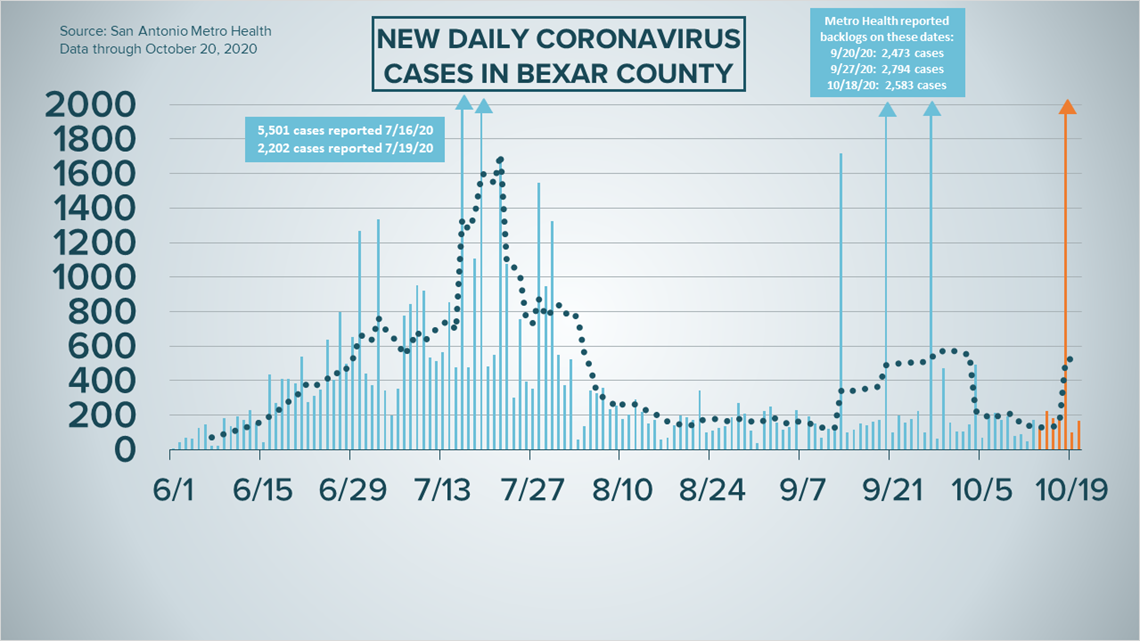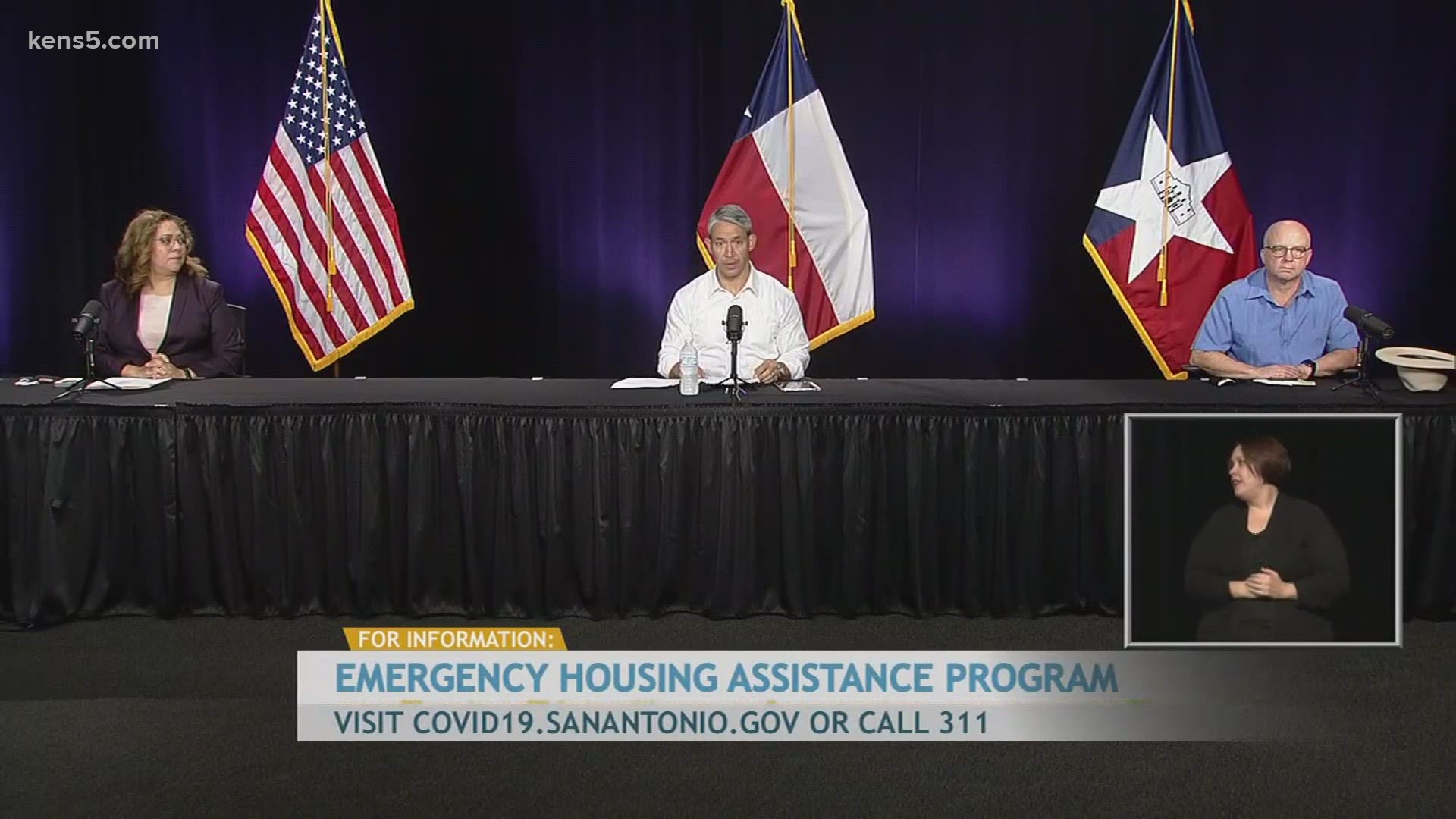SAN ANTONIO — We're tracking the latest numbers from the coronavirus pandemic in San Antonio and across Texas. Here are the latest numbers reported by Bexar and surrounding counties:
- Bexar County: 168 new cases were reported Tuesday, bringing the total number of cases for the county to 63,594. no new deaths were reported; the county's death toll remains at 1,230.
- Comal County: The county reported 17 additional cases and no additional virus-related deaths on Tuesday. There have been a total of 3,659 cases of COVID-19 in the county – including 2,823 confirmed cases – while 120 county residents have died. County officials say there are 102 active coronavirus cases, and 3,437 residents are considered recovered.
- Hays County: Officials in Hays County on Wednesday reported 34 new cases in the county and no additional virus-related deaths. As of Wednesday, there are a total of 6,246 lab-confirmed cases in the county (609 of which are active) while the death toll sits at 64. 5,573 residents have recovered from the virus.
How Bexar County is trending
We've tracked how many coronavirus cases have been confirmed in Bexar County from the time officials began reporting cases in March 2020. The graphic below shows the number of cases since June and charts those daily case numbers along a 7-day moving average to provide a more accurate picture of the overall coronavirus case curve in our area and the direction we're trending amid the pandemic.
On Tuesday, San Antonio Mayor Ron Nirenberg reported an additional 168 cases in Bexar County, bringing the total to 63,594. The county's moving average for newly reported cases over a seven-day span is now 158.


No additional deaths were reported Tuesday; in all, 1,230 county residents have died from virus complications.
As of Tuesday, 189 county residents were receiving treatment for their symptoms in the hospital. Of those, 42 patients were using ventilators and 91 were in intensive care.


Coronavirus in Texas
The number of Texans who have tested positive for the coronavirus since the pandemic began grew by 5,030 on Tuesday, according to the Texas Department of State Health Services.
4,856 of those are new diagnoses over the last 24 hours, while the other 174 cases stem from a number of backlogs in several counties. More details can be found at the top of this page.


In total, 833,557 coronavirus cases have been confirmed in Texas.
State health authorities reported 65 additional virus-related deaths on Tuesday. At least 17,087 Texans have passed away from COVID-19 complications.
Meanwhile, COVID-19-related hospitalizations took a steep rise Tuesday. 269 more Texans were receiving treatment for COVID-19 than Monday, bringing the current total to 4,588.
Health officials warn that the state is currently in another surge. Experts attribute the spike in COVID-19 numbers to "pandemic fatigue."
The state estimates that 733,758 Texans have recovered, while 83,973 Texans remain ill with COVID-19.
Meanwhile, the Texas Education Agency updated its online coronavirus database to show that there have been 15,898 cumulative cases among staff and students across the state as of Oct. 15. More information can be found here.
The TEA releases new data on school cases every Thursday.
Latest Coronavirus Headlines
- McConnell warns White House against stimulus deal with Pelosi
- Family who lost mother to coronavirus stresses the need for life insurance
- Cough keeps Melania Trump off the campaign trail
- Coronavirus in winter | Risky behaviors to be wary of during the chilly months
- Who's Hiring: Companies still looking for employees during coronavirus pandemic
- Few fans, masked umps, muted celebrations for World Series
- What are the treatment options for COVID-19?
- President Trump goes after Fauci, tries to buck up his campaign team
- COVID-19 relief, stimulus checks may be far off as Tuesday deadline looms
Coronavirus symptoms
The symptoms of coronavirus can be similar to the flu or a bad cold. Symptoms include fever or chills, cough, shortness of breath or difficulty breathing, fatigue, muscle or body aches, headache, new loss of taste or smell sore throat, congestion or runny nose, nausea or vomiting and diarrhea, according to the Centers for Disease Control.
Most healthy people will have mild symptoms. A study of more than 72,000 patients by the Centers for Disease Control in China showed 80 percent of the cases there were mild.
But infections can cause pneumonia, severe acute respiratory syndrome, kidney failure, and even death, according to the World Health Organization. Older people with underlying health conditions are most at risk.
But infections can cause pneumonia, severe acute respiratory syndrome, kidney failure, and even death, according to the World Health Organization. Older people with underlying health conditions are most at risk.
Experts determined there was consistent evidence these conditions increase a person's risk, regardless of age:
- Chronic kidney disease
- COPD (chronic obstructive pulmonary disease)
- Obesity (BMI of 30 or higher)
- Immunocompromised state (weakened immune system) from solid organ transplant
- Serious heart conditions, such as heart failure, coronary artery disease, or cardiomyopathies
- Sickle cell disease
- Type 2 diabetes
The CDC believes symptoms may appear anywhere from two to 14 days after being exposed.
Human coronaviruses are usually spread...
- Between people who are in close contact with one another (within about 6 feet).
- Through respiratory droplets produced when an infected person coughs, sneezes or talks. These droplets can land in the mouths or noses of people who are nearby or possibly be inhaled into the lungs.
- Some recent studies have suggested that COVID-19 may be spread by people who are not showing symptoms.
Help stop the spread of coronavirus
- Stay home when you are sick.
- Eat and sleep separately from your family members
- Use different utensils and dishes
- Cover your cough or sneeze with your arm, not your hand.
- If you use a tissue, throw it in the trash.

